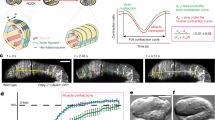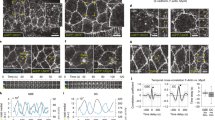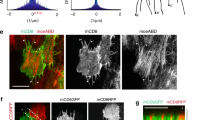Abstract
Dorsal closure is a morphogenetic process involving the coordinated convergence of two epithelial sheets to enclose the Drosophila melanogaster embryo. Specialized populations of cells at the edges of each epithelial sheet, the dorsal-most epidermal cells, emit actin-based processes that are essential for the proper enclosure of the embryo. Here we show that actin dynamics at the leading edge is preceded by a planar polarization of the dorsal-most epidermal cells associated with a reorganization of the cytoskeleton. An important consequence of this planar polarization is the formation of actin-nucleating centres at the leading edge, which are important in the dynamics of actin. We show that Wingless (Wg) signalling and Jun amino-terminal kinase (JNK) signalling have overlapping but different roles in these events.
This is a preview of subscription content, access via your institution
Access options
Subscribe to this journal
Receive 12 print issues and online access
$209.00 per year
only $17.42 per issue
Buy this article
- Purchase on Springer Link
- Instant access to full article PDF
Prices may be subject to local taxes which are calculated during checkout







Similar content being viewed by others
References
Martinez Arias, A. in The Development of Drosophila (eds Bate, M. & Martinez Arias, A.) 517–608 (Cold Spring Harbor Laboratory Press, Cold Spring Harbor, NY 1993).
Young, P. E., Richman, A. M., Ketchum, A. S. & Kiehart, D. P. Morphogenesis in Drosophila requires nonmuscle myosin heavy chain function. Genes Dev. 7, 29–41 (1993).
Jacinto, A., Martinez-Arias, A. & Martin, P. Mechanisms of epithelial fusion and repair. Nature Cell Biol. 3, E117–E123 (2001).
Noselli, S. & Agnes, F. Roles of the JNK signaling pathway in Drosophila morphogenesis. Curr. Opin. Genet. Dev. 9, 466–472. (1999).
Stronach, B. E. & Perrimon, N. Stress signaling in Drosophila. Oncogene 18, 6172–6182 (1999).
Ring, J. M. & Martinez Arias, A. puckered, a gene involved in position-specific cell differentiation in the dorsal epidermis of the Drosophila larva. Development (Suppl.) 251–259 (1993).
Jacinto, A. et al. Dynamic actin-based epithelial adhesion and cell matching during Drosophila dorsal closure. Curr. Biol. 10, 1420–1426 (2000).
Kiehart, D. P., Galbraith, C. G., Edwards, K. A., Rickoll, W. L. & Montague, R. A. Multiple forces contribute to cell sheet morphogenesis for dorsal closure in Drosophila. J. Cell Biol. 149, 471–490 (2000).
Glise, B., Bourbon, H. & Noselli, S. hemipterous encodes a novel Drosophila MAP kinase kinase, required for epithelial cell sheet movement. Cell 83, 451–461 (1995).
Glise, B. & Noselli, S. Coupling of Jun amino-terminal kinase and Decapentaplegic signaling pathways in Drosophila morphogenesis. Genes Dev. 11, 1738–1747 (1997).
Harden, N., Loh, H. Y., Chia, W. & Lim, L. A dominant inhibitory version of the small GTP-binding protein Rac disrupts cytoskeletal structures and inhibits developmental cell shape changes in Drosophila. Development 121, 903–914 (1995).
Hou, X. S., Goldstein, E. S. & Perrimon, N. Drosophila Jun relays the Jun amino-terminal kinase signal transduction pathway to the Decapentaplegic signal transduction pathway in regulating epithelial cell sheet movement. Genes Dev. 11, 1728–1737 (1997).
Kockel, L., Zeitlinger, J., Staszewski, L. M., Mlodzik, M. & Bohmann, D. Jun in Drosophila development: redundant and nonredundant functions and regulation by two MAPK signal transduction pathways. Genes Dev. 11, 1748–1758. (1997).
Riesgo-Escovar, J. R. & Hafen, E. Drosophila Jun kinase regulates expression of decapentaplegic via the ETS-domain protein Aop and the AP-1 transcription factor DJun during dorsal closure. Genes Dev. 11, 1717–1727 (1997).
Ricos, M. G., Harden, N., Sem, K. P., Lim, L. & Chia, W. Dcdc42 acts in TGF-beta signaling during Drosophila morphogenesis: distinct roles for the Drac1/JNK and Dcdc42/TGF-β cascades in cytoskeletal regulation. J. Cell Sci. 112, 1225–1235 (1999).
Reed, B. H., Wilk, R. & Lipshitz, H. D. Downregulation of Jun kinase signaling in the amnioserosa is essential for dorsal closure of the Drosophila embryo. Curr. Biol. 11, 1098–1108 (2001).
Shimada, Y., Usui, T., Yanagawa, S., Takeichi, M. & Uemura, T. Asymmetric colocalization of Flamingo, a seven-pass transmembrane cadherin, and Dishevelled in planar cell polarization. Curr. Biol. 11, 859–863 (2001).
Adler, P. N. & Lee, H. Frizzled signaling and cell-cell interactions in planar polarity. Curr. Opin. Cell Biol. 13, 635–640 (2001).
Takahashi, K., Matsuo, T., Katsube, T., Ueda, R. & Yamamoto, D. Direct binding between two PDZ domain proteins Canoe and ZO-1 and their roles in regulation of the jun N-terminal kinase pathway in Drosophila morphogenesis. Mech. Dev. 78, 97–111 (1998).
Woods, D. F., Hough, C., Peel, D., Callaini, G. & Bryant, P. J. Dlg protein is required for junction structure, cell polarity, and proliferation control in Drosophila epithelia. J. Cell Biol. 134, 1469–1482 (1996).
Eaton, S., Wepf, R. & Simons, K. Roles for Rac1 and Cdc42 in planar polarization and hair outgrowth in the wing of Drosophila. J. Cell Biol. 135, 1277–1289 (1996).
Eaton, S. Planar polarization of Drosophila and vertebrate epithelia. Curr. Opin. Cell Biol. 9, 860–866 (1997).
Strutt, D. I., Weber, U. & Mlodzik, M. The role of RhoA in tissue polarity and Frizzled signalling. Nature 387, 292–295 (1997).
Boutros, M., Paricio, N., Strutt, D. I. & Mlodzik, M. Dishevelled activates JNK and discriminates between JNK pathways in planar polarity and wingless signaling. Cell 94, 109–118 (1998).
Craig, G. et al. Notch regulates actin cytoskeletal organisation and the activity of cellular protrusions during dorsal closure in Drosophila. (submitted).
Stronach, B. & Perrimon, N. Activation of the JNK pathway during dorsal closure in Drosophila requires the mixed lineage kinase, slipper. Genes Dev. 16, 377–387 (2002).
Heisenberg, C. P. et al. Silberblick/Wnt11 mediates convergent extension movements during zebrafish gastrulation. Nature 405, 76–81 (2000).
Tada, M. & Smith, J. C. Xwnt11 is a target of Xenopus Brachyury: regulation of gastrulation movements via Dishevelled, but not through the canonical Wnt pathway. Development 127, 2227–2238 (2000).
Wallingford, J. B. et al. Dishevelled controls cell polarity during Xenopus gastrulation. Nature 405, 81–85 (2000).
Yamanaka, H. et al. JNK functions in the non-canonical Wnt pathway to regulate convergent extension movements in vertebrates. EMBO Rep. 3, 69–75 (2002).
McEwen, D. G., Cox, R. T. & Peifer, M. The canonical Wg and JNK signaling cascades collaborate to promote both dorsal closure and ventral patterning. Development 127, 3607–3617 (2000).
Snow, P. M., Bieber, A. J. & Goodman, C. S. Fasciclin III: a novel homophilic adhesion molecule in Drosophila. Cell 59, 313–323 (1989).
Perrimon, N. & Mahowald, A. P. Multiple functions of segment polarity genes in Drosophila. Dev. Biol. 119, 587–600 (1987).
Klein, T. & Arias, A. M. Different spatial and temporal interactions between Notch, wingless, and vestigial specify proximal and distal pattern elements of the wing in Drosophila. Dev. Biol. 194, 196–212 (1998).
Brand, A. H. & Perrimon, N. Targeted gene expression as a means of altering cell fates and generating dominant phenotypes. Development 118, 401–415 (1993).
Axelrod, J. D., Miller, J. R., Shulman, J. M., Moon, R. T. & Perrimon, N. Differential recruitment of Dishevelled provides signaling specificity in the planar cell polarity and Wingless signaling pathways. Genes Dev. 12, 2610–2622 (1998).
van de Wetering, M. et al. Armadillo coactivates transcription driven by the product of the Drosophila segment polarity gene dTCF. Cell 88, 789–799 (1997).
Pai, L. M., Orsulic, S., Bejsovec, A. & Peifer, M. Negative regulation of Armadillo, a Wingless effector in Drosophila. Development 124, 2255–2266 (1997).
Perrimon, N. The maternal effect of lethal(1)discs-large-1: a recessive oncogene of Drosophila melanogaster. Dev Biol 127, 392–407 (1988).
Zecchini, V., Brennan, K. & Martinez-Arias, A. An activity of Notch regulates JNK signalling and affects dorsal closure in Drosophila. Curr. Biol. 9, 460–469 (1999).
Fernandez, R. et al. The Drosophila shark tyrosine kinase is required for embryonic dorsal closure. Genes Dev. 14, 604–614 (2000).
Lu, Y. & Settleman, J. The Drosophila Pkn protein kinase is a Rho/Rac effector target required for dorsal closure during embryogenesis. Genes Dev. 13, 1168–1180 (1999).
Harden, N. et al. Drac1 and Crumbs participate in amnioserosa morphogenesis during dorsal closure in Drosophila. J.Cell Sci 115, 2119–2129 (2002).
Magie, C. R., Meyer, M. R., Gorsuch, M. S. & Parkhurst, S. M. Mutations in the Rho1 small GTPase disrupt morphogenesis and segmentation during early Drosophila development. Development 126, 5353–5364 (1999).
Hakeda-Suzuki, S. et al. Rac function and regulation during Drosophila development. Nature 416, 438–442 (2002).
Strutt, D. I. Asymmetric localization of frizzled and the establishment of cell polarity in the Drosophila wing. Mol. Cell 7, 367–375 (2001).
Chou, T. B. & Perrimon, N. Use of a yeast site-specific recombinase to produce female germline chimeras in Drosophila. Genetics 131, 643–653 (1992).
Ashburner, M. Drosophila: A Laboratory Manual. (Cold Spring Harbour Laboratory Press, Cold Spring Harbour, NY, 1989).
Lehmann, R. & Tautz, D. In situ hybridization to RNA. Methods Cell Biol. 44, 575–598 (1994).
Acknowledgements
We thank D. Bohman, P. J. Bryant, R. Karess, T. Uemura and D. Yamamoto for primary antibodies; D. Strutt for the Fz–GFP stock; J. Axelrod for the Dsh–GFP and UAS–Dsh stocks; and P. Martin for encouragement, tutorials and comments. This work was supported by The Wellcome Trust (J.K., N.L., A.P., T.B. and A.M.A.), the Association pour la Recherche sur le Cancer (V.M.) and the Fundação Ciência e Tecnologia (A.J. and B.G.F.).
Author information
Authors and Affiliations
Corresponding author
Ethics declarations
Competing interests
The authors declare no competing financial interests.
Supplementary information
Supplementary figures
Figure S1 Z sections taken through DME cells of wild type embryos (12 hour AEL) showing, from left to right, the relative distributions of FasIII, α-Catenin, ActinGFP, Canoe, Flamingo and Frizzled in the apico-basal axis of the cells. (PDF 1640 kb)
Figure S2 Addition of phalloidin to the fixation solution stabilises the actin cytoskeleton at the LE of wild type embryos and hep1 mutant embryos but not wingless mutant embryos. thin actin cable at the LE.
Rights and permissions
About this article
Cite this article
Kaltschmidt, J., Lawrence, N., Morel, V. et al. Planar polarity and actin dynamics in the epidermis of Drosophila. Nat Cell Biol 4, 937–944 (2002). https://doi.org/10.1038/ncb882
Received:
Revised:
Accepted:
Published:
Issue Date:
DOI: https://doi.org/10.1038/ncb882
This article is cited by
-
Amnioserosa cell constriction but not epidermal actin cable tension autonomously drives dorsal closure
Nature Cell Biology (2016)
-
Microtubule organization is determined by the shape of epithelial cells
Nature Communications (2016)
-
Orchestrating size and shape during morphogenesis
Nature (2007)
-
Identification and analysis of cabut orthologs in invertebrates and vertebrates
Development Genes and Evolution (2007)
-
Protocadherin FAT1 binds Ena/VASP proteins and is necessary for actin dynamics and cell polarization
The EMBO Journal (2004)



